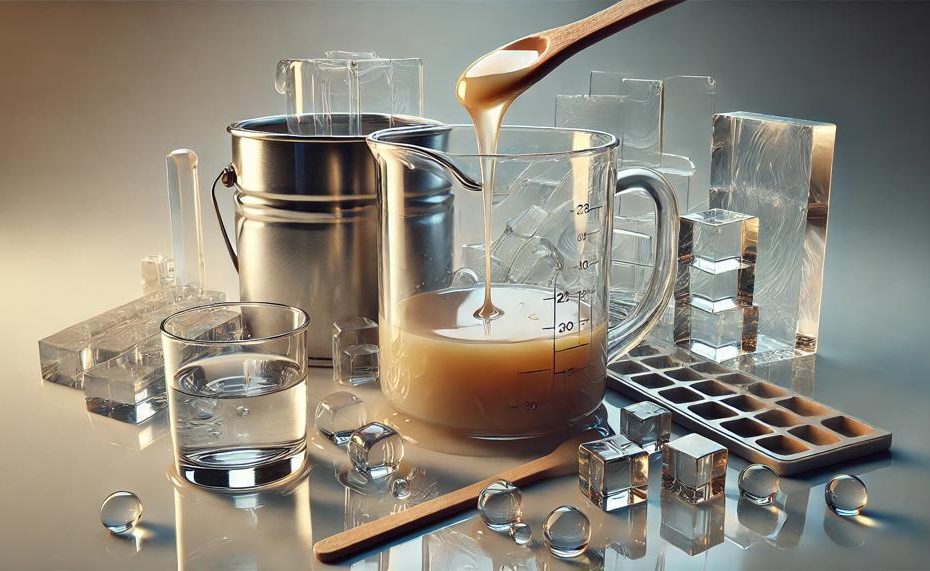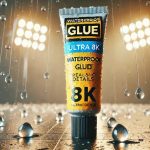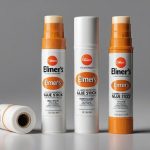Yes, epoxy can come off glass, but it’s no easy feat. Removing epoxy adhesive from glass surfaces is a delicate task that requires patience and the right approach. Here are the key takeaways:
- The ease of removal depends on the type of epoxy and how long it has cured on the glass.
- Common methods involve scraping with a razor blade, using solvents like acetone or alcohol, or applying heat to soften the epoxy.
- However, these techniques may not work for everyone and could potentially damage the glass if not done carefully.
🔑 Compelling Hook: Imagine having a pristine glass surface marred by unsightly epoxy stains or residue. Removing epoxy from glass can be a daunting challenge, but it’s one that’s worth taking on to restore the clarity and beauty of your glass surfaces. In this introduction, we’ll explore the possibilities and pitfalls of getting rid of stubborn epoxy, so you can make an informed decision on the best approach for your needs.
With the right information and techniques, you can successfully remove epoxy from glass and breathe new life into your glass surfaces. Stay tuned as we dive into the details and provide you with the tools you need to tackle this task head-on.
Table of Contents
- 1 How to Remove Wet Epoxy From Glass?
- 1.1 Gather Supplies
- 1.2 Ensure Ventilation
- 1.3 Apply Acetone
- 1.4 Allow to Soak
- 1.5 Scrape Carefully
- 1.6 Dispose Properly Discard the removed epoxy and soiled rags in a sealed container for proper disposal. How to Remove Cured Epoxy From Glass? Removing cured epoxy from glass surfaces can be a delicate task, but several effective methods can help you tackle this challenge. Here are some proven techniques to consider: Method Description Considerations Scraping Use a razor blade or putty knife to gently scrape off the hardened epoxy. Start at the edges and work your way inwards. Be careful not to scratch the glass surface. This method may leave some residue behind. Heat Gun Apply heat from a heat gun or hairdryer to soften the epoxy, then scrape it off while it’s still warm and pliable. Use caution to avoid cracking the glass or burning yourself. Work in a well-ventilated area. Chemical Solvents Apply acetone, vinegar, or specialized epoxy removers to the cured epoxy, allowing it to soak in before scraping or wiping off the softened residue. Wear protective gear like gloves and goggles, and work in a well-ventilated area. Test on a small inconspicuous area first. Abrasive Methods Use fine-grit sandpaper or a Dremel tool with a sanding attachment to carefully grind away the epoxy residue. Exercise extreme caution to avoid scratching or damaging the glass surface. This method may leave visible marks. It’s essential to exercise patience and take the necessary safety precautions when removing cured epoxy from glass. You may need to combine multiple methods or seek professional assistance for particularly stubborn or delicate cases. 5 safety precautions when removing epoxy from glass Wear Protective Gear
- 1.7 Ensure Proper Ventilation
- 1.8 Test for Compatibility
- 1.9 Avoid Harsh Scraping
- 1.10 Dispose Safely
- 2 How To Remove Epoxy From Glass Without Scratching the Surface?
- 3 Conclusion
How to Remove Wet Epoxy From Glass?
Here are the steps to safely and effectively remove wet epoxy from glass:
Gather Supplies
Collect acetone, a scraper or knife, gloves, safety goggles, and a disposal dish.
Ensure Ventilation
Work in a well-ventilated area to avoid inhaling fumes from the acetone or epoxy.
Apply Acetone
Soak a clean cloth with acetone and gently rub it onto the wet epoxy area.
Allow to Soak
Let the acetone soak into the epoxy for a few minutes to soften it.
Scrape Carefully
Use a scraper or knife to gently lift and remove the softened epoxy, avoiding scratching the glass.
Dispose Properly
Discard the removed epoxy and soiled rags in a sealed container for proper disposal.
How to Remove Cured Epoxy From Glass?
Removing cured epoxy from glass surfaces can be a delicate task, but several effective methods can help you tackle this challenge. Here are some proven techniques to consider:
Method
Description
Considerations
Scraping
Use a razor blade or putty knife to gently scrape off the hardened epoxy. Start at the edges and work your way inwards.
Be careful not to scratch the glass surface. This method may leave some residue behind.
Heat Gun
Apply heat from a heat gun or hairdryer to soften the epoxy, then scrape it off while it’s still warm and pliable.
Use caution to avoid cracking the glass or burning yourself. Work in a well-ventilated area.
Chemical Solvents
Apply acetone, vinegar, or specialized epoxy removers to the cured epoxy, allowing it to soak in before scraping or wiping off the softened residue.
Wear protective gear like gloves and goggles, and work in a well-ventilated area. Test on a small inconspicuous area first.
Abrasive Methods
Use fine-grit sandpaper or a Dremel tool with a sanding attachment to carefully grind away the epoxy residue.
Exercise extreme caution to avoid scratching or damaging the glass surface. This method may leave visible marks.
It’s essential to exercise patience and take the necessary safety precautions when removing cured epoxy from glass. You may need to combine multiple methods or seek professional assistance for particularly stubborn or delicate cases.
5 safety precautions when removing epoxy from glass
Wear Protective Gear
Don protective equipment like gloves, goggles, and a respirator mask to shield your skin, eyes, and lungs from irritants or fumes.
Ensure Proper Ventilation
Work in a well-ventilated area or set up fans to circulate air and prevent inhalation of toxic vapors released during epoxy removal.
Poor ventilation can lead to chemical exposure risks.
Test for Compatibility
Conduct a spot test on an inconspicuous area to ensure the solvent or method used won’t damage or discolor the glass surface.
Different glass types may react differently to solvents and abrasives.
Avoid Harsh Scraping
Use plastic scrapers or dull blades to gently remove softened epoxy, avoiding excessive force that could scratch the glass.
Dispose Safely
Collect and dispose of epoxy residue, solvents, and cleaning materials properly according to local hazardous waste regulations.
Improper disposal can harm the environment and health.
How To Remove Epoxy From Glass Without Scratching the Surface?
Removing epoxy from glass without scratching or damaging the surface requires a delicate approach and the right techniques. Here are some effective methods to safely remove epoxy from glass:
Method
Description
Precautions
Heat Gun
Use a heat gun or hairdryer to gently heat the epoxy, causing it to soften and become pliable.
Once softened, carefully scrape off the epoxy with a plastic putty knife or razor blade held at a flat angle.

- Avoid overheating the glass, which can cause cracking or shattering.
- Work in a well-ventilated area to dissipate fumes.
Solvent
- Apply a solvent like acetone or isopropyl alcohol to the epoxy, allowing it to soak for several minutes.
- The solvent will help break down the epoxy, making it easier to scrape off with a plastic scraper.
- Use solvents in a well-ventilated area and wear protective gloves.
- Test the solvent on a small, inconspicuous area first to ensure it doesn’t damage the glass.
Adhesive Remover
- Apply a commercial adhesive remover designed for epoxy or super glue to the affected area.
- Allow it to sit for the recommended time, then scrape off the softened epoxy with a plastic scraper.
Conclusion
Here is a 200 word blog post conclusion summarizing the key points about removing epoxy from glass surfaces:
Restoring clarity to glass marred by epoxy residue is an achievable goal with the right approach. While removing cured epoxy can be challenging, a combination of mechanical and chemical methods can effectively break the stubborn bonds. Gentle scraping with plastic tools, carefully applied heat to soften the epoxy, and judicious use of solvents like acetone have all proven successful. However, it’s crucial to take proper safety precautions like wearing protective gear and ensuring adequate ventilation to avoid inhaling toxic fumes.
For newly spilled epoxy, acting quickly is key – use acetone to dissolve and wipe away the uncured material before it fully sets. No matter the scenario, patience and persistence are vital. Test methods on inconspicuous areas first, and dispose of waste properly. With the right techniques and precautions, you can restore glass surfaces to their original pristine condition free of unsightly epoxy stains.
You may also like:

- Avoid overheating the glass, which can cause cracking or shattering.
- Work in a well-ventilated area to dissipate fumes.
- Apply a solvent like acetone or isopropyl alcohol to the epoxy, allowing it to soak for several minutes.
- The solvent will help break down the epoxy, making it easier to scrape off with a plastic scraper.
- Use solvents in a well-ventilated area and wear protective gloves.
- Test the solvent on a small, inconspicuous area first to ensure it doesn’t damage the glass.
- Apply a commercial adhesive remover designed for epoxy or super glue to the affected area.
- Allow it to sit for the recommended time, then scrape off the softened epoxy with a plastic scraper.






